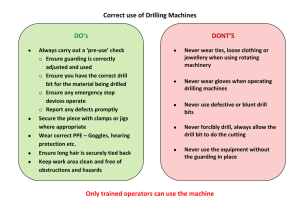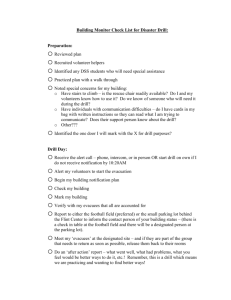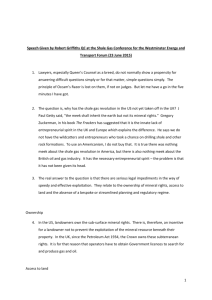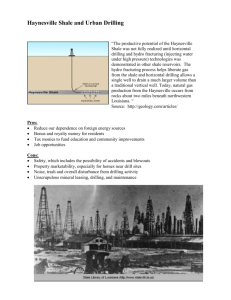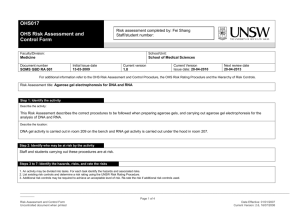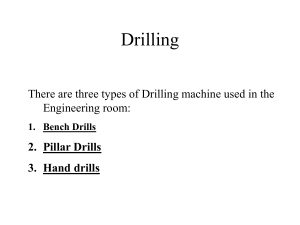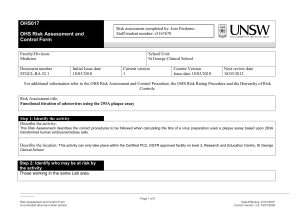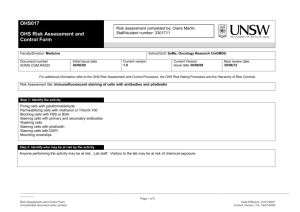RA9 Bench Drill Ope..
advertisement
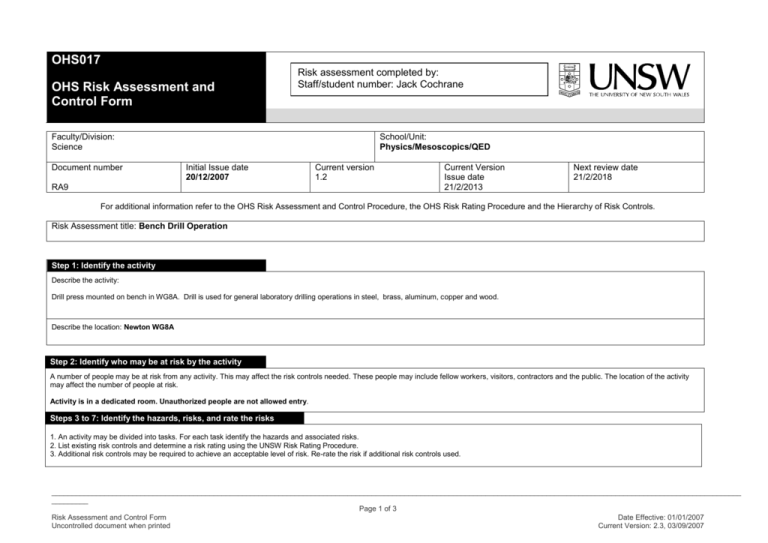
OHS017 OHS Risk Assessment and Control Form Risk assessment completed by: Staff/student number: Jack Cochrane Faculty/Division: Science Document number School/Unit: Physics/Mesoscopics/QED Initial Issue date 20/12/2007 RA9 Current version 1.2 Current Version Issue date 21/2/2013 Next review date 21/2/2018 For additional information refer to the OHS Risk Assessment and Control Procedure, the OHS Risk Rating Procedure and the Hierarchy of Risk Controls. Risk Assessment title: Bench Drill Operation Step 1: Identify the activity Describe the activity: Drill press mounted on bench in WG8A. Drill is used for general laboratory drilling operations in steel, brass, aluminum, copper and wood. Describe the location: Newton WG8A Step 2: Identify who may be at risk by the activity A number of people may be at risk from any activity. This may affect the risk controls needed. These people may include fellow workers, visitors, contractors and the public. The location of the activity may affect the number of people at risk. Activity is in a dedicated room. Unauthorized people are not allowed entry. Steps 3 to 7: Identify the hazards, risks, and rate the risks 1. An activity may be divided into tasks. For each task identify the hazards and associated risks. 2. List existing risk controls and determine a risk rating using the UNSW Risk Rating Procedure. 3. Additional risk controls may be required to achieve an acceptable level of risk. Re-rate the risk if additional risk controls used. __________________________________________________________________________________________________________________________________________________________________________ _________ Page 1 of 3 Risk Assessment and Control Form Date Effective: 01/01/2007 Uncontrolled document when printed Current Version: 2.3, 03/09/2007 Tasks Hazards Associated risks (Step 3) (Step 4) Risk rating with existing controls * Additional risk controls required Risk Rating with additional controls * (Step 5) (Step 6) (Step 7) Existing risk controls C Setting up drill press L R Falling parts Damage to legs and toes if parts fall from bench Wear strong enclosed boots/shoes 2 C L Setting up Drilling operations Manual Handling Cuts, bruises, back strain Training 2 D L Changing drill bits. Cleaning shavings. Sharp Objects Cuts to fingers Training. Stop drill, use brush to remove shavings 2 C M Rotating parts Damage to eyes, face, and body Training in correct use of machine. Wear Eye protection 3 C H Flying debris Cuts to eyes and face Training. Use Perspex drill chuck guard in lowered position during drilling. Wear Eye protection/face shield 1 C L Hot parts Burns to fingers Correct training. Use correct drill and speed for material. Use lubricants on steel and do not force drill. Withdraw regularly and clean shavings from drill 1 D L Drilling Drilling Drilling * C = consequence L = likelihood R = risk rating (Apply the hierarchy of risk controls) Use clamps to secure work piece. Tie up loose hair. Secure loose clothing. Do not wear jewellery. Do not wear gloves. C 2 L C R M from the UNSW Risk Rating Procedure Step 8 Documentation and initial approval Completed by: (name) Jack Cochrane (signature) Authorised by: (name) (signature) Date: __________________________________________________________________________________________________________________________________________________________________________ _________ Page 2 of 3 Risk Assessment and Control Form Date Effective: 01/01/2007 Uncontrolled document when printed Current Version: 2.3, 03/09/2007 Step 9: Implement the additional risk controls identified Indicate briefly what additional risk controls from Step 6 above were implemented, when and by whom. Risk control: Clamps to secure work piece. Tie up loose hair. Secure loose clothing. Do not wear jewellery. Do not wear gloves. Date: Risk control: Date: Implemented by: Risk control: Date: Implemented by: Risk control: Date: Implemented by: Risk control: Date: Implemented by: 20/12/07 Implemented by: Jack Cochrane Step 10: Monitor and review the risk controls It is important to monitor risk controls and review risk assessments regularly. Review is required when there is a change in the process, relevant legal changes, and where a cause for concern has arisen. Reviews could be scheduled on an annual basis. If the risk assessment has substantially changed a new risk assessment is warranted. Review date: 20/12/08 Reviewed by: Authorised by: Review date: Reviewed by: Authorised by: Review date: Reviewed by: Authorised by: Review date: Reviewed by: Authorised by: Review date: Reviewed by: Authorised by: Documentation It is a requirement that legal and advisory documentation that supports this risk assessment be listed. Such documentation includes Acts, Regulations, Australian Standards and Codes of Practice, where applicable. AS 2243.6-1990 Safety in Laboratories/Mechanical Aspects. Section 2.1, 2.2.1/2.2.2 __________________________________________________________________________________________________________________________________________________________________________ _________ Page 3 of 3 Risk Assessment and Control Form Date Effective: 01/01/2007 Uncontrolled document when printed Current Version: 2.3, 03/09/2007
